Small things - big difference
This page is a simple list of things that you can do and prepare for relating to exam technique. Small things that can make a big difference. We should all know that there are more things to life than exams (although it doesn't feel like it when exams are just around the corner) We should also know that without good exam technique, we don't always do ourselves justice under pressure. It is important to pay attention to the little details! Here we go.
Calculator settings
These are just a few things you would do well to be on top of. Last minute hassle related to this is not helpful so it is good idea just to check these things off when you can.
- RAM - make sure you know how to clear it/set you GDC in exam mode
- Afterwards - make sure your GDC is in degree mode
- Ti users - make sure you have turned ‘Diagnostics On’ (so you get the PMCC result for linear regression)
- Make sure your batteries are full OR have spare ones
- Practice some of the key skills (see later slide)
Know what to expect
Sounds silly, but often these are things people don't think about and you can be caught unaware. It helps a lot to know what you are expecting so that you know where you are at any given point!
Paper 1
- You get 5 minutes reading time, THEN
- Exam lasts 90 minutes
- 14 questions worth 6 marks or less each (total 80)
- A mark a minute with 10 minutes to spare
- They are supposed to get more difficult as you go through.
- All your working should be on the exam paper
Paper 2
- You get 5 minutes reading time, THEN
- Exam lasts 90 minutes
- 6 questions worth a total of 80 marks. (not all the same)
- A mark a minute with 10 minutes to spare
- You MUST show working out. For some questions the answer is not enough.
GDC and Formula booklet
- You are allowed both of these for both of your exams.
- Be familiar with how you can use both to your advantage.
Use reading time well
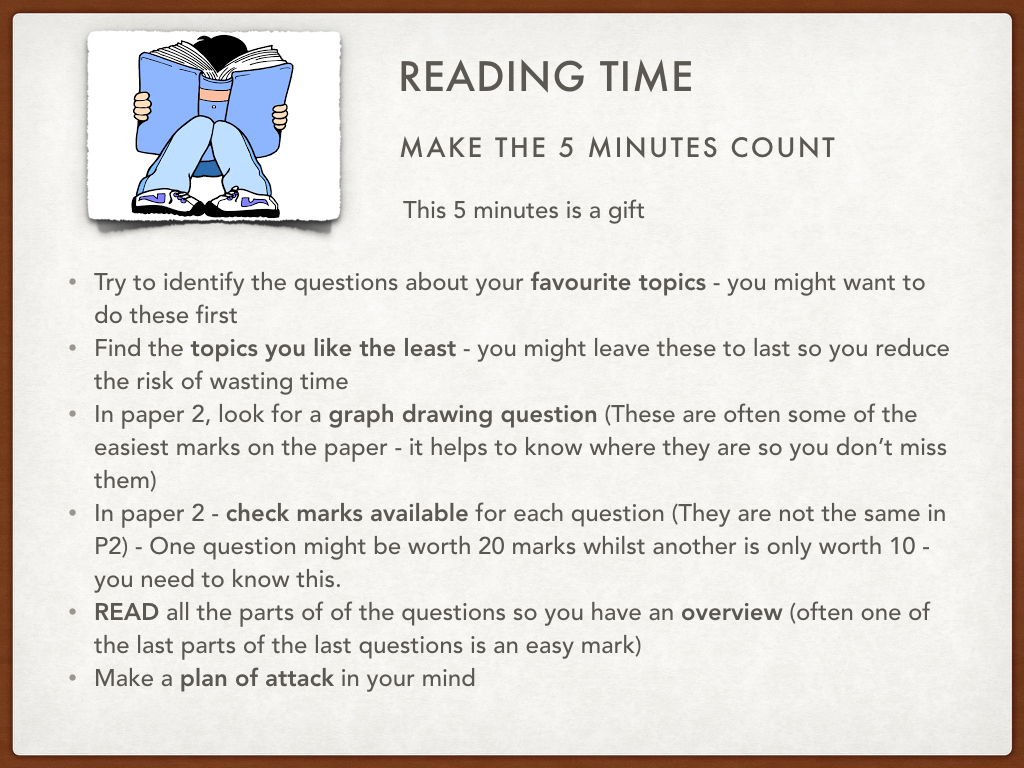 You are given 5 minutes at the start of each exam that you are allowed to use to read through the exam paper. you are only allowed to read - not make notes at all, but you can achieve a lot of useful things during this time. It is a gift and needs to be used wisely.
You are given 5 minutes at the start of each exam that you are allowed to use to read through the exam paper. you are only allowed to read - not make notes at all, but you can achieve a lot of useful things during this time. It is a gift and needs to be used wisely.
- Try to identify the questions about your favourite topics - you might want to do these first
- Find the topics you like the least - you might leave these to last so you reduce the risk of wasting time
- In paper 2, look for a graph drawing question (These are often some of the easiest marks on the paper - it helps to know where they are so you don’t miss them)
- In paper 2 - check marks available for each question (They are not the same in P2) - One question might be worth 20 marks whilst another is only worth 10 - you need to know this.
- READ all the parts of of the questions so you have an overview (often one of the last parts of the last questions is an easy mark)
- Make a plan of attack in your mind
Formula booklet
This is another great tool you have at your disposal and you should know how it well.
- Take your own copy, read it, annotate it and make sure you know exactly what is in it…..
- Don’t waste time memorising things that you are given…. Just make sure you know how to use them

Think about your target
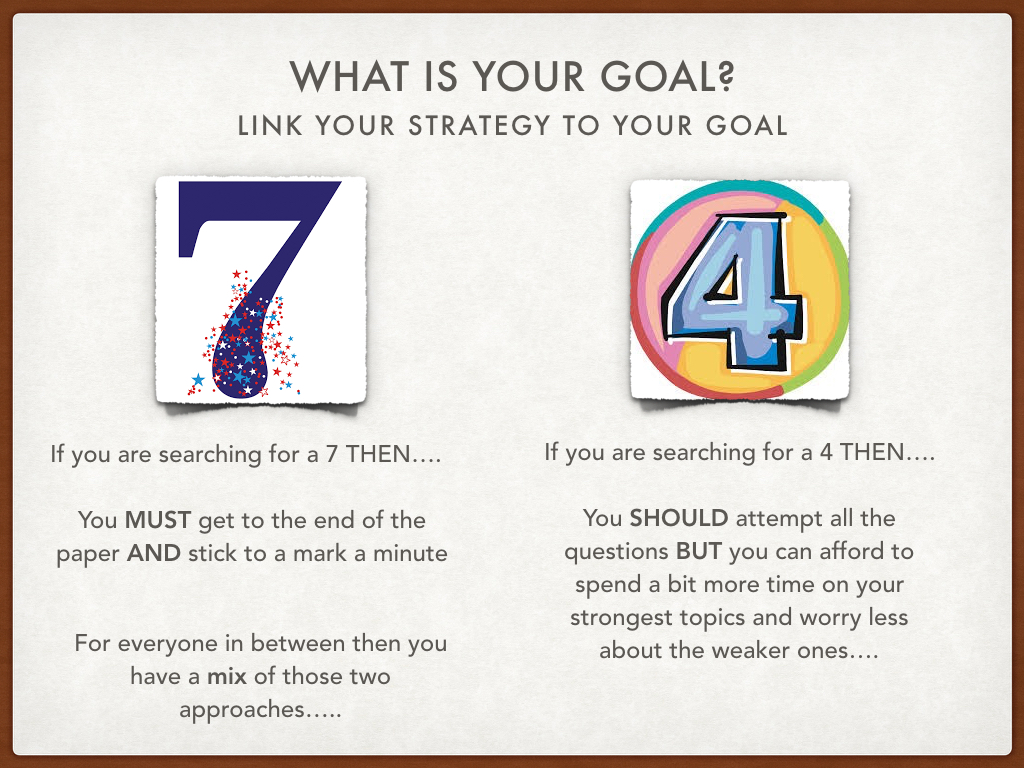 If you are searching for a 7 THEN….
If you are searching for a 7 THEN….
You MUST get to the end of the paper AND stick to a mark a minute
If you are searching for a 4 THEN….
You SHOULD attempt all the questions BUT you can afford to spend a bit more time on your strongest topics and worry less about the weaker ones….
For everyone in between then you have a mix of those two approaches…..
Question spotting
You are NOT ALLOWED to discuss the exam outside your school community
Your teacher is NOT ALLOWED to see the exam until 24 hours later
BUT You SHOULD get together after paper 1 (straight after the exam) and LIST the topics that were in paper 1.
IF they weren’t covered in Paper 1, then you can be fairly sure that they will be in Paper 2.
This can help you decide what to concentrate on in the evening between Paper 1 and Paper 2
Working and thinking
It is crucial that you write down your thoughts as you are working. Your exam paper will be scanned in to a computer and marked by someone, somewhere else who has know idea who you are and how you think. THEY CANT READ YOUR MIND, you have to help them understand what you were thinking, even if you think it is obvious. IF YOU THINK IT, WRITE ITV DOWN
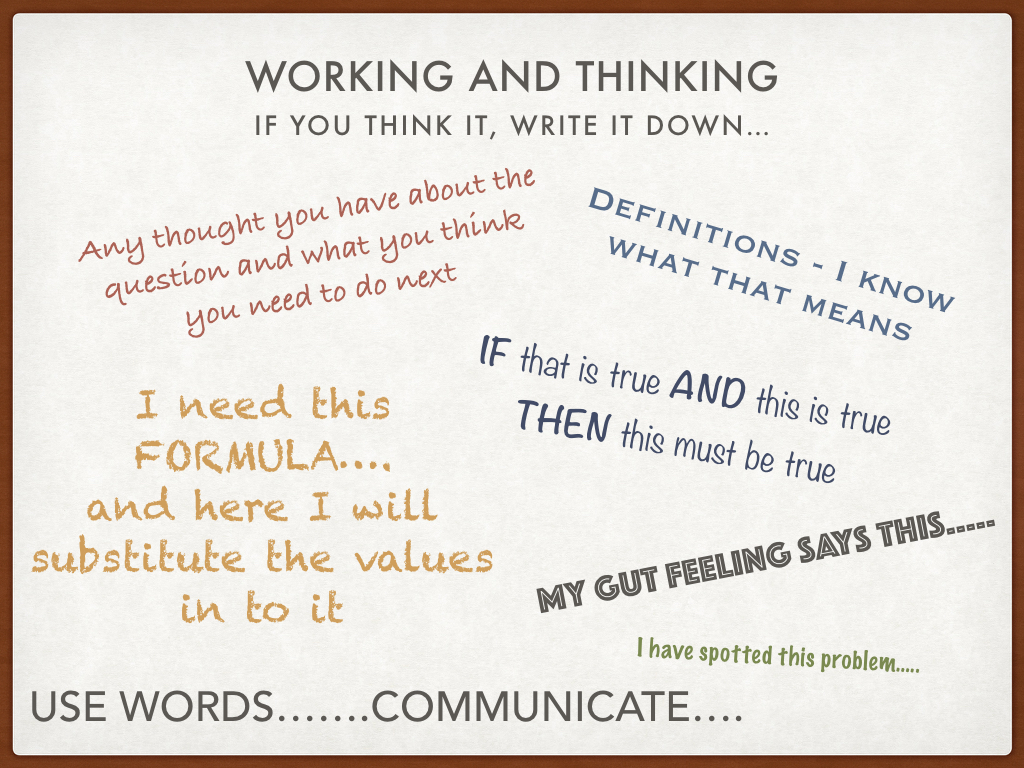 Any thought you have about the question - this is like word association. When we se problems we have immediate responses that help us us to think of a strategy. You want to convince an examiner that your thoughts are relevant and helpful for solving the problem. If you don't write it down, they won't know.
Any thought you have about the question - this is like word association. When we se problems we have immediate responses that help us us to think of a strategy. You want to convince an examiner that your thoughts are relevant and helpful for solving the problem. If you don't write it down, they won't know.
Definitions - Questions contain key words. If you know what those words mean, then you can access the question. Show the examiner you know what they mean.
If that is true and this is true then this must be true - Any given question will give you some information. You are supposed to use that information to create new information. If you do that in any way, then write it down to show the examiner you are making progress, even if it isn't immediately obvious how you will use that next....
The formula you are thinking about using - If you are asked for the volume of the shape in the picture (lets say it is a cuboid), you know that volume = length X width X height, so WRITE IT DOWN so we can all se how clever you are.... (for other examples, it might be as simple as copying down a formula from the formula booklet so that you can show us you know what the relevant formula is. EVEN if you don't know exactly what to do with it next, this is already worth something.
The substitutions, a = ... etc.... - To continue the example used above, the next stage is to get the numbers (or letters) given in the question for length, width and height and substitute them. Write the formula again, with these values/letters instead. Again, this is thinking worth sharing. It shows you knew the next step, even if you don't know where to go next. These can be crucial marks.
The problem you spotted - If you see a problem that steps you going forward, then say so. Sometimes, just the process of writing this down can help you develop your thoughts and it light be worth something.
Your gut feeling - If you think it, share it! As above, sometimes, just the process of writing this down can help you develop your thoughts and it light be worth something.
Scrapping
Like the supermarket sweep, you must not miss any opportunity to make the most of your 90 minutes. I have a lot of respect for students in this situation, but little patience for those that sit there twiddling their thumbs for 20 minutes at the end and not making the most of the ONLY opportunity they have to get extra marks.
9 marks that you scrapped around for is an extra 10%
- Double check the ones you are confident about to minimise the chance of careless errors
- Make sure you have at least READ every part of every question AND got all the hidden easy marks….
- and written down any associated thought, idea, formula, conclusion that you can think of…
- Don’t get put off by the beginnings of questions….
- Mostly, you have the information you need to do ‘part 3’ even if you couldn’t do ‘part 2’ and then ‘part 6’ is an easy gift - DON’T MISS these
Accuracy
 What
What
- Round to 3 significant figures unless…..
- The question says otherwise (2dp, whole number etc)
- Its money - then use 2dp (unless it says otherwise
When
- Try to leave rounding to the last moment of the question
- Then write your full calculator display
- Then round and state the degree of accuracy you used
Units
Make sure you say what quantity are you talking about

Show that..
The answer is in the question...
- Learn to love these….
- You know what you should get so you know how you are doing…
- 1 mark a minute. If you have used the time, then move on…..
- You can CONTINUE THE QUESTION even if you couldn’t show it (don’t get put off)
Example
Show that the volume can be expressed as
V = x2h
You are expected to use the information you have t and the formula for volume and substitute
Try - but if you can’t do it, move on
Accurate graph drawing and sketching

Drawing to scale
- Use a sharp pencil and a ruler
- Use the correct scale - see the question
- Plot points accurately (Just be careful)
- Join with line/curve as appropriate
- Label axes and add name/title
- Include requested details from question
Sketching
- Use a sharp pencil and a ruler
- Join with line/curve as appropriate
- Label axes and add name/title
- Include Key Points and requested details from question
Setting out (answer space)
Try to be Coherent
- Use words to link your working out together
- Make sure you put your answer in the answer space
- Show your steps vertically, one under the other (not horizontally)
- Underline/highlight key results and answers
- Read it through to check that it would make sense to someone else
- For paper 2, label the parts of your work so that it corresponds to the question
- For paper 2, make sure part 1 follows part 2

Calculator Skills (sub divisions) Viewing windows, gsolve, lists, frequency, solver
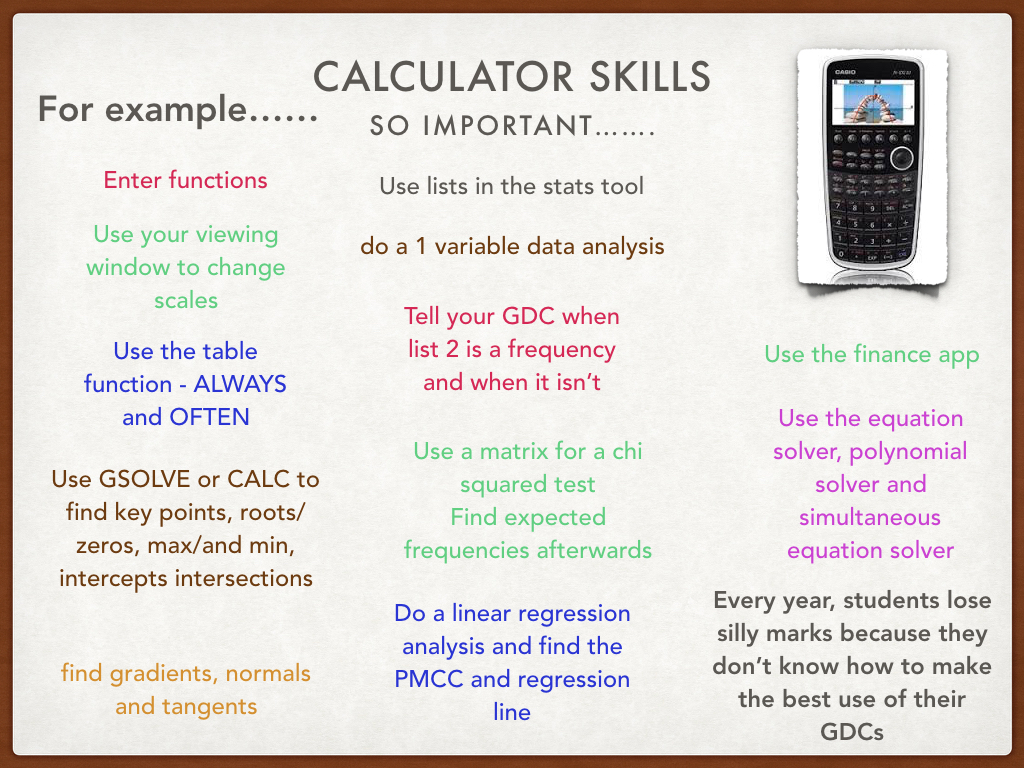
- Enter functions
- Use your viewing window to change scales
- Use the table function - ALWAYS and OFTEN
- Use GSOLVE or CALC to find key points, roots/zeros, max/and min, intercepts intersections
- find gradients, normals and tangents
- Use lists in the stats tool
- do a 1 variable data analysis
- Tell your GDC when list 2 is a frequency and when it isn’t
- Use a matrix for a chi squared test
- Find expected frequencies afterwards
- Do a linear regression analysis and find the PMCC and regression line
- Use the finance app
- Use the equation solver, polynomial solver and simultaneous equation solver
- Use the distributions calculator for Normal and Binomial distributions
- T-tests and chi squared goodness of fit tests
Every year, students lose silly marks because they don’t know how to make the best use of their GDCs
How much of Exam Advice have you understood?












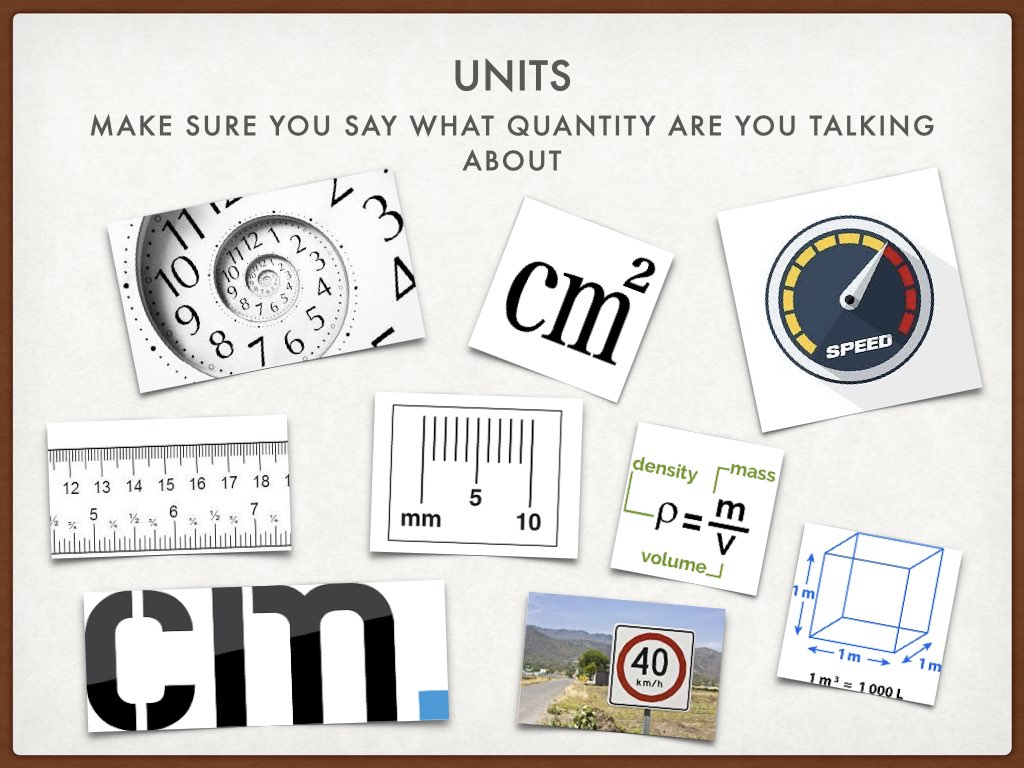
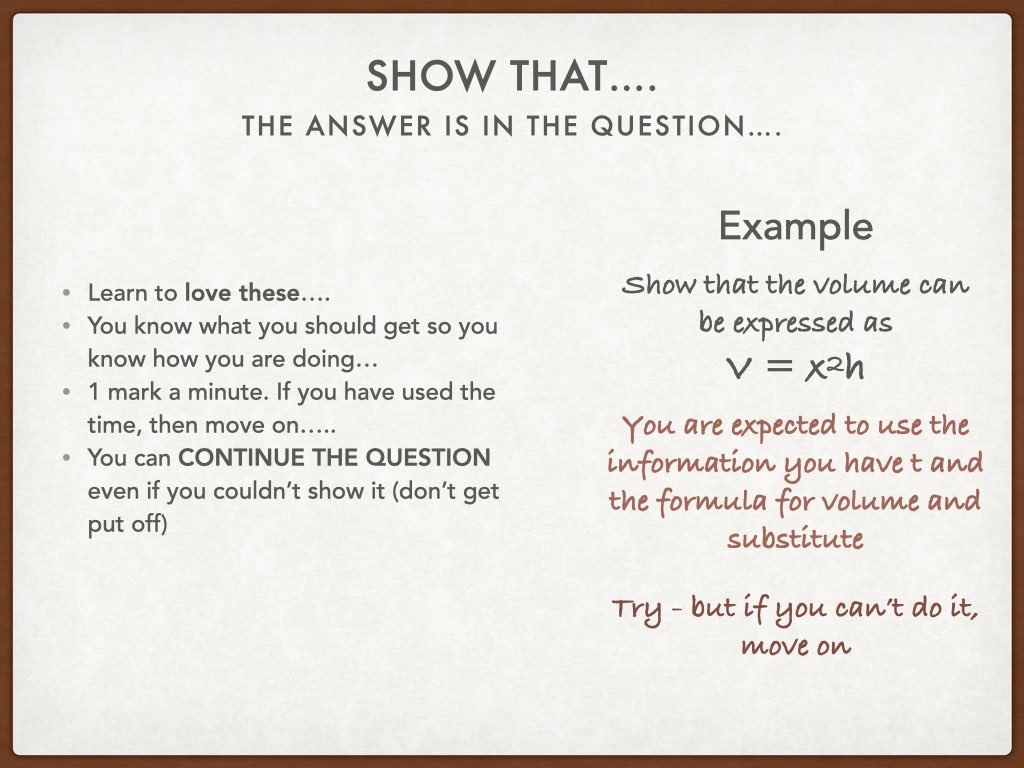

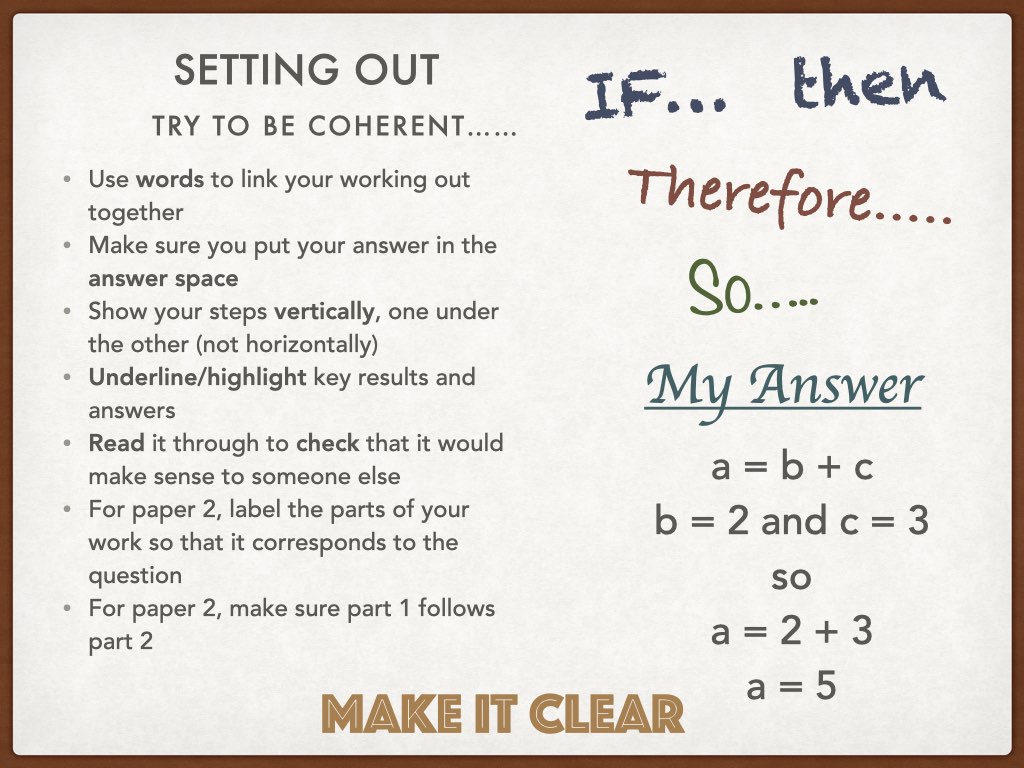





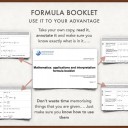
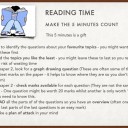











 Twitter
Twitter  Facebook
Facebook  LinkedIn
LinkedIn